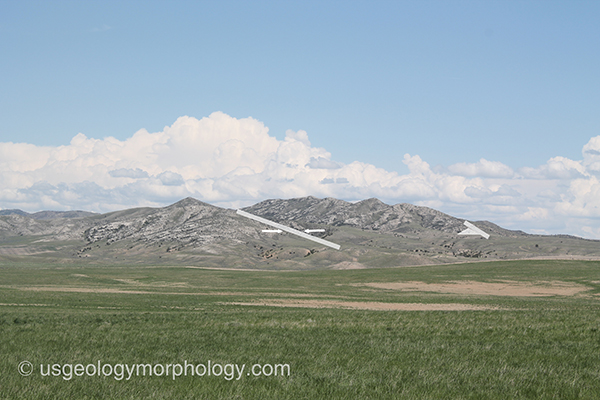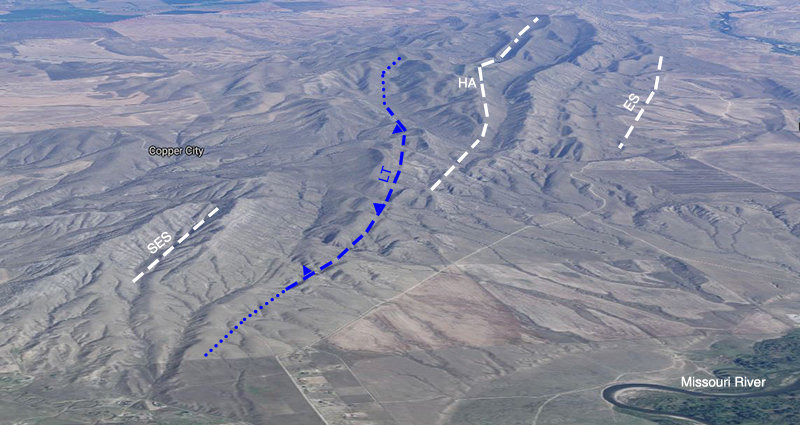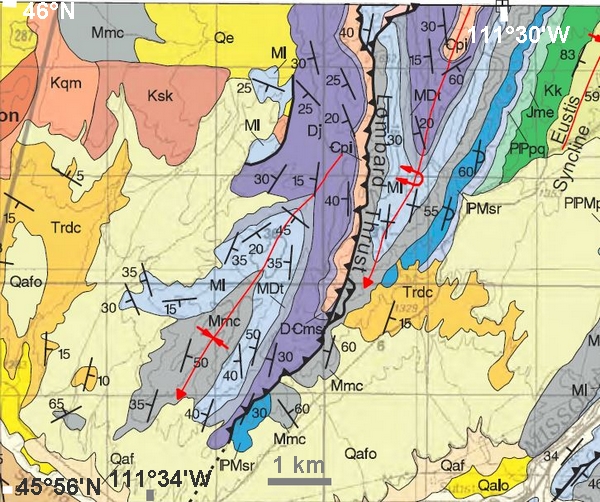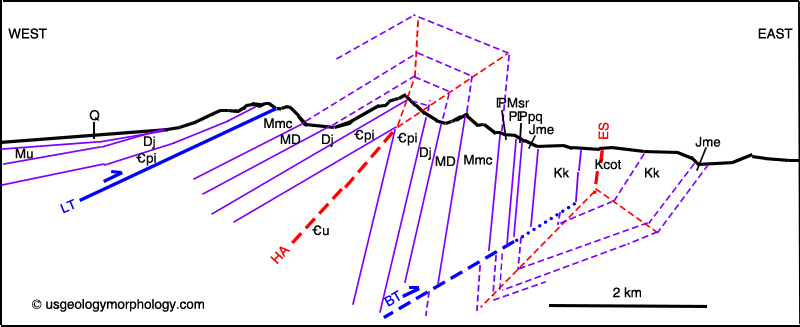Lombard Thrust, Southwestern Montana (cont.)
Three Forks Area (cont.)
2.2 Lombard Thrust in the Hossfeldt Hills
Most of the Lombard thrust is inferred, because it's buried under younger sediments. Between the Toston and Milligan areas, the thrust outcrops in the Hossfeldt Hills, where interesting folds are associated with it. Figure 2-6 shows a syncline west of the thrust, i.e. "behind" its front. The 3-D view in figure 2.7 maps two more folds east of the thrust, the Hossfeldt anticline and the Eustis syncline, associated with compression when the thrust moved eastward.

Figure 2-6. Hossfeldt Hills, Montana.
View to the northwest. The Hossfeldt Hills are a few miles north of Three Forks. The white line with arrows shows the north-northeast-striking syncline at the southeastern end of the Hossfeldt Hills. The white line with a sawtooth represents the trace of the Lombard thrust (sawtooth on overriding plate). The Hossfeldt anticline is beyond the skyline and not visible on this photo. Foreground: Three Forks basin.

Figure 2-7. 3-D view of the Hossfeldt Hills, Montana.
Blue dashed line (dotted when inferred): Lombard thrust (LT) with sawteeth on the overriding plate. White dashed lines: fold axial planes. HA: Hossfeldt anticline. ES: Eustis syncline. SES: syncline at the southeast of the hills (see fig. 2-6). Base image: Google Maps © Google. Google and the Google logo are registered trademarks of Google Inc., used with permission.
At first sight, as seen on the aerial view above, the syncline at the southeast (SES) and the Hossfeldt anticline have a distinctive and typical chevron shape (V-shape for the syncline, inverted V-shape for the anticline), underlined by the parallel ridges corresponding to the more competent (harder) rock layers (Dj, Ml, and Mmc; see fig. 2-8). The Eustis syncline, formed in strata of similar competence, is much flatter. However, its proximity to the Hossfeldt anticline and the Lombard thrust suggests that a link to these features is likely. It is common to find folds ahead of a thrust because of the compression and the migration of the thrust (eastward here). Currie et al. (1962) showed that folding in a multi-layered sequence is led by the more competent layers, and they calculated the relation between the thickness of the leading layers to the fold wavelength. Following these workers, Mitchell and Woodward (1988), noticed that the distance between the axes of the Hossfeldt and Eustis folds corresponds to a half-wavelength for a 300 m thick buckling layer, which approximately corresponds to the thickness of the Mission Canyon limestone (Ml; up to 460 m in the Three Forks area, after Vuke et al., 2014). That would argue in favor of a buckle-fold nature for the Hossfeldt anticline, but, noting its kink-like (angular) geometry and its asymmetric character with much of the deformation in the forelimb, the authors concluded it was a kink-buckle fold above a detachment. Fischer et al. (1992) agreed with this interpretation of the Hossfeldt anticline as a kink-buckle fold, underlining that it must have developped first as a buckle fold, then evolved into an overturned kink fold, with increased compression and deformation.

Figure 2-8. Geologic map of the southern part of the Hossfeldt Hills, Montana.
The Cambrian Pilgrim Limestone (_pi) has been thrusted over the Mississipian Mission Canyon Limestone (Mmc). The Hossfeldt anticline is indicated by the red line immediately to the east of the Lombard thrust. The Eustis syncline is in the northeast corner. Note the syncline west of the thrust (illustrated in fig. 2-6), the axis of which is approximately parallel to the thrust. Other thrusts to the east (Trident, Green and Cottonwood thrusts, outside the map) are also accompanied by parallel-striking folds.
Rock units: _pi: Cambrian Pilgrim limestone; Dj: Devonian Jefferson formation; MDt: Mississippian-Devonian Three Forks formation; Ml: Mississippian Lodgepole limestone; Mmc: Mission Canyon limestone; *Msr: Pennsylvanian-Miss. Snowcrest Range group; P*pq: Permian-Penns. Phosphoria and Quadrant formations, undivided; Jme: Jurassic Morrison formation and Ellis group, undivided; Kk: Cretaceous Kootenai formation; Kcot: Cody through Thermopolis formations, undivided.
Source: Bozeman 30x60 geologic map (Vuke et al., 2014). See the explanation of other symbols therein.
Figure 2-9. 3-D geologic diagram of the Hossfeldt anticline and the Eustis syncline.
View of the map of fig. 2-8 in 3-D. The horizon is on the parallel 46° N. Vertical exaggeration: 2x. Sources: USGS DEM, Bozeman 30x60 geologic map (Vuke et al., 2014).
Robinson (1963), Mitchell and Woodward (1988), and Vuke et al. (2014) all published small-scale cross-sections of the Hossfeldt anticline and the Eustis syncline. Robinson drew the Hossfeldt anticline as a simple overturned kink fold, but at the price of a great variation of the Jefferson formation (Dj) thickness between the two fold limbs. Mitchell and Woodward showed the Eustis syncline with two kink-bands, but they represented the Hossfeldt anticline at a very small scale. The cross-section by Vuke et al. is even smaller (it covers a much larger area), but reveals a blind thrust below the Hossfeldt anticline.
I present below (fig. 2-10) the balanced cross-section I tried to make, taking in account the thickness and the slope of each layer, as well as the blind thrust. Some slope angles are indicated on Vuke et al.'s map (2014). The authors give also the average thickness of each layers, but I was more guided by the size of each outcrop. For example, a balanced cross-section must accommodate very dissimilar exposures of the Jefferson formation (Dj) on the two limbs of the anticline. It is the same with the layer symbolized by "Jme" in the Eustis syncline. I had to infer the position of the blind thrust. On Vuke et al.'s cross-section it only cuts Paleozoic rocks, which seems unlikely for a thrust parallel to the Lombard thrust, which is not older than early Cretaceous time. Also, the displacement along this thrust is unknown and I had to make a guess. Of course, these are approximations, but the overall pattern of my cross-section should not be too far from reality, and it would suggest that these two folds are fault-propagation folds.

Figure 2-10. Cross-section of the Hossfeldt anticline and the Eustis syncline.
Cross-section along the parallel 46° N. Blue line: Lombard thrust plane (LT). Blue dashed line: blind thrust (BT; dotted when suggested). Thick red dashed lines: fold axial planes. Thin red dashed lines: kink planes. HA: Hossfeldt anticline. ES: Eustis syncline. Purple lines: layer boundaries (dashed when inferred). Rock units are designated by the same symbols as in fig. 2-8, except: _u, Cambrian rocks, older than _pi, undivided, MD, Mississippian Lodgepole limestone and Miss.-Devonian Three Forks formation, undivided, Mu, Mississippian, undivided, and Q, Quaternary deposits. Vertical exaggeration: 2x. Sources: USGS DEM, Fischer et al. (1992), Mitchell and Woodward (1988), Robinson (1963, 1967), Vuke (2009), Vuke et al. (2002, 2014).
